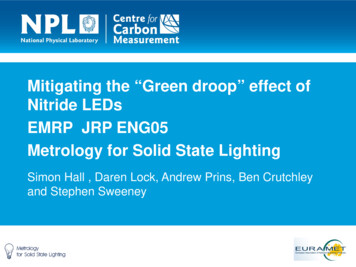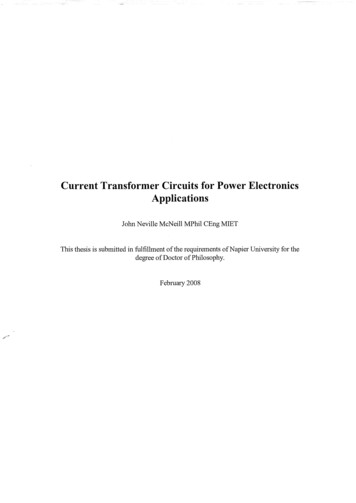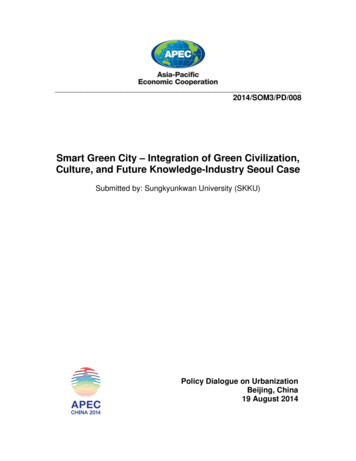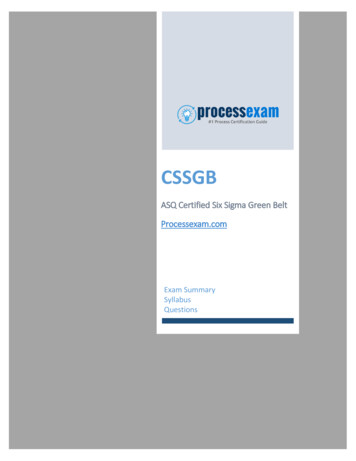
Transcription
Mitigating the “Green droop” effect ofNitride LEDsEMRP JRP ENG05Metrology for Solid State LightingSimon Hall , Daren Lock, Andrew Prins, Ben Crutchleyand Stephen Sweeney24th April 2013
Solid State LightingRequirementsSocietal Need: Energy savingsTraceable metrology Reduced carbon footprintLongevityLower maintenance costs Energy efficient lighting for domestic, industrial andpublic spacesColour differentiationHuman factors Address fragmented EU metrology2
“Green Droop” effectfor Nitride LEDs
Photon absorption ina p-n homojunction
Resonant absorption technique formeasuring band gap of Light Emitting edLEDDiode (LEDreflectorreflectorreflected rayreflected rayFibre –coupleddirect rays direct raysLaser Diodedome lensdome tection
Resonant absorption technique for measuringband gap of Light Emitting Diodes (LEDs)AFibre-coupledLaser source
Existing methods Wavelength shiftJ. Senawiratne, A. Chatterjee, T. Detchprohm, W. Zhao, Y. Li, M. Zhu, Y. Xia, X. Li, J. Plawsky,C. Wetzel, “Junction temperature, spectral shift, and efficiency in GaInN-based blue and greenlight emitting diodes”, Thin Solid Films 518, 1732 (2010). Spectral analysisZ. Vaitonis, P. Vitta, and A. Žukauskas, "Measurement of the junction temperature in high-powerlight-emitting diodes from the high-energy wing of the electroluminescence band", J. Appl. Phys.103, 093110 (2008) Forward voltage techniqueXi and E. F. Schubert, "Junction–temperature measurement in GaN ultraviolet light-emittingdiodes using diode forward voltage method", Appl. Phys. Lett. 85, 2163 (2004).
Theory of measurement Blue emitting devices have theability to generate photocurrent inanother blue device due tooverlapping emission andabsorption edges The large Stoke’s shift of the greendevices, show that a blue deviceshould also be able to generate aphotocurrent in a green device The emission of the Blue LED sitson the Urbach tail of both Greenand Blue Urbach tail is T and is a materialproperty
Forward voltagemeasurementgreen (NSPG510S)Nichia InGaN LED T is the measuredJt – Bulk TPulsed dutycycle 0.1 %Fv 87 0C ( T is 67 0C 200C bulk) at 80mA
Experimental set-upDevices drilled toaccept POF thenpolishedNichia blue (NSPB510s)Nichia green (NSPG510S)Two pulse generators witha linked triggerVoltage measurement isacross a 47Ω resistorPump fixed at 100 mAfor all measurements
Pulse RegimesGreen device PulseBlue pump Pulse
Thermal Co-efficientsT(t) T0 ΔT0e-t/τwhere T(t) is the time (t)dependence of the absolutedevice temperature, T0 is theambient temperature and ΔT0is the initial temperatureabove ambient.References indicate our LEDtype will have a 1-2 ms timeco-efficientA measurement within 1 ms of the device switching off willbe between 30% and 60% of the device temperature atswitch offQ. Shan, Q. Dai, S. Chhajed, J. Cho, and E. F. Schubert “Analysis of thermal properties of GaInN light-emittingdiodes and laser diodes”, J. Appl. Phys. 108, 084504, 2010.P. Vitta and A. Žukauskas "Thermal characterization of light-emitting diodes in the frequency domain" Phys. StatusSolidi C 6, S877 (2009).
CalibrationVOpen CircuitMosfetPumpCalibration rBlue pump set at 100 mAPulse Voltage (V)Green device held opencircuit1.31.21.11.00.90.8Bulk temperature set bythermal chamber0.70.60102030405060Bulk Temperature (C)708090100
Junction TemperatureBulk Temperatureα V1 - V0Where V1 is the measured voltage under zero device drive currentAnd V0 the voltage at 0 0CVoltage rise due to extra heating (V2 - α) γWhere V2 is the measured voltage under operationAnd γ is the adjustment for temperature decreaseJunction Temperature, Tj (V2 - α) γWhereis the gradient from the calibration graph
Initial measurementsMeasurements of the Blue pump pulse heightwith increasing Green device drive currentBlue pump pulse height
Temperature co-efficientWith a 1 ms Blue pulse delay, the temperature co-efficient (γ) is between 30 to 90 % ofthe device temperatureWe can plot 30%,60% and 90%values of γ.From references we expectthese devices to have 60 %due to their construction andpackaging styleComparison with Forwardvoltage techniques isconsistent with 60% T is the measured Jt – Bulk TQ. Shan, Q. Dai, S. Chhajed, J. Cho, and E. F. Schubert “Analysis of thermal properties of GaInN light-emittingdiodes and laser diodes”, J. Appl. Phys. 108, 084504, 2010.P. Vitta and A. Žukauskas "Thermal characterization of light-emitting diodes in the frequency domain" Phys.Status Solidi C 6, S877 (2009).
ResultsUtilising a temperature coefficient of 60% we can see thatthere is good agreement withour measured forward voltagetechniqueJT 86 0C ( T is 66 0C 200C bulk) at 80mAFv 87 0C ( T is 67 0C 200C bulk) at 80mA
Further work Measurements of Urbach tail shift with temperature Application of this technique to blue devices Investigate the technique with the two devices closecoupled Investigate the technique at raised temperatures Increase the Technology Readiness Level of the techniqueso that it can be exploited commercially
Conclusions We have demonstrated a novel technique formeasuring junction temperature. Measurements of the junction temperature of a GreenLED device has been shown. The technique shouldalso work for Blue emitting devices. Comparison with the forward voltage technique showsgood agreement. Technique is dependent upon Urbach tail and istherefore a material property.GB Patent Application No. 1207503.2 – Apparatus and method formonitoring LED efficiencyGB Patent Application No.1207505.7 – Apparatus and method formonitoring LED colour mix
Conclusions (2) Development of a measurement of junctiontemperature, independent of electrical behaviour Ability to measure in-situ within a luminaire withoutadditional architecture Ability to measure both blue and green devices inRGB system to provide stability control for colourrendition
Thank you foryour attentionWith acknowledgement to EMRP
Xi and E. F. Schubert, "Junction–temperature measurement in GaN ultraviolet light-emitting diodes using diode










